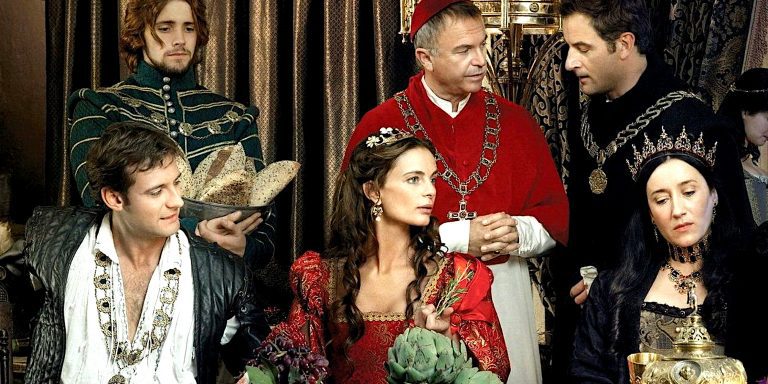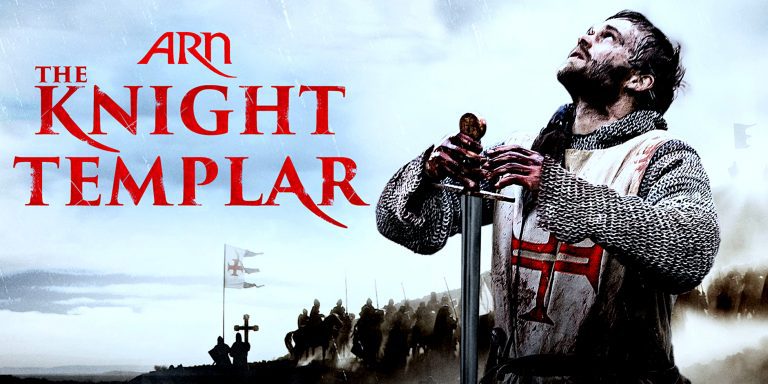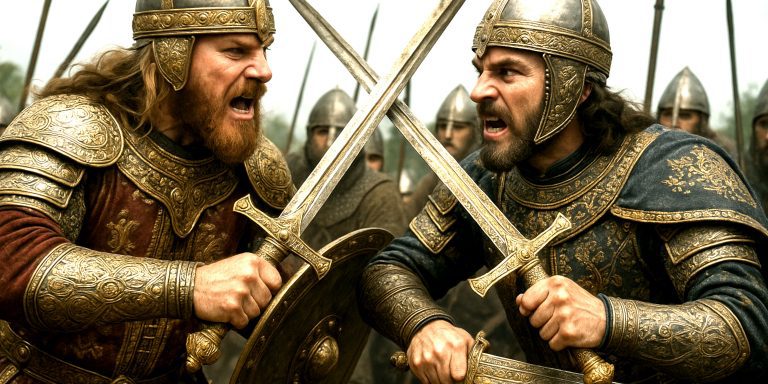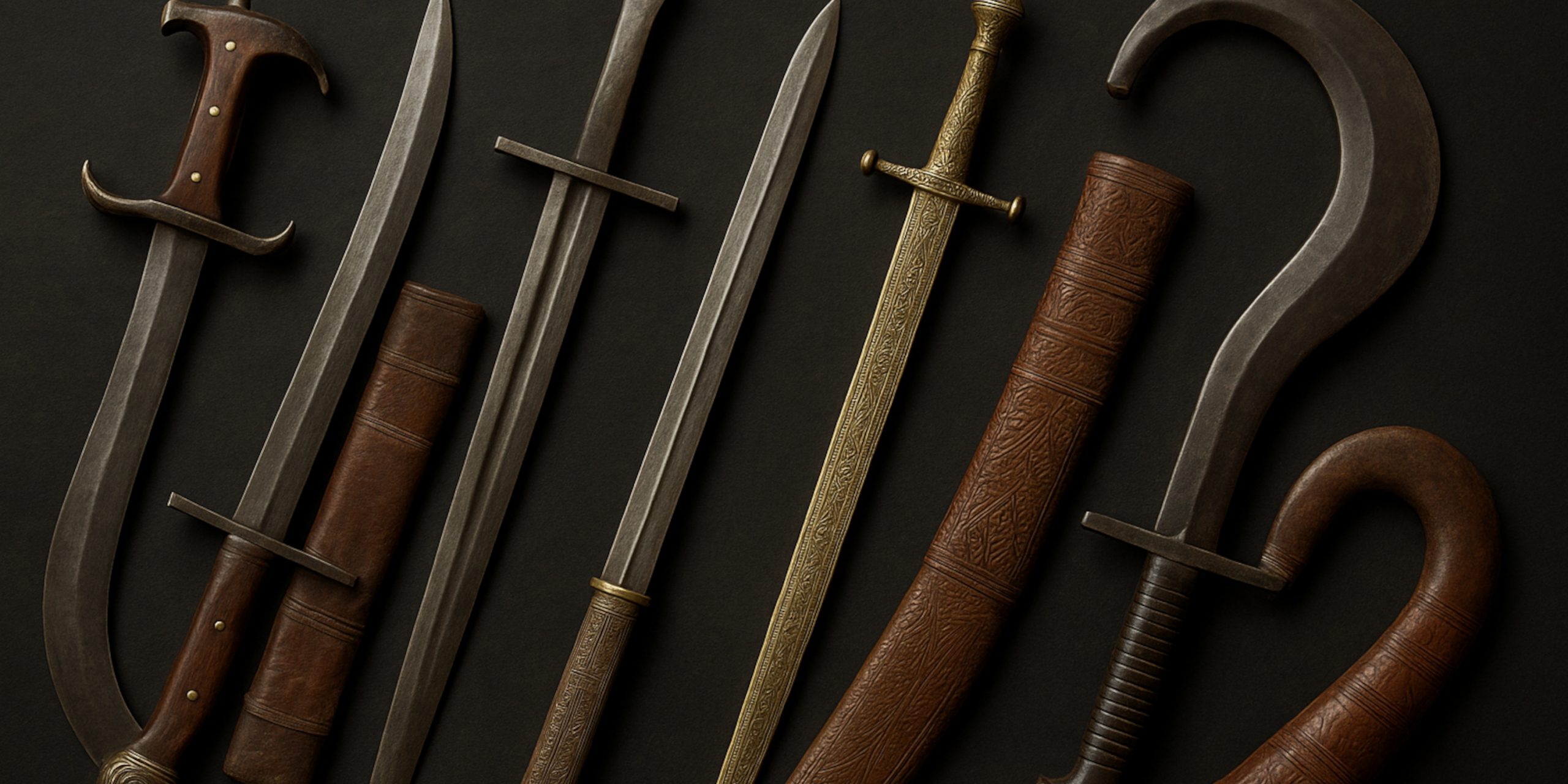
African sword traditions reflect the continent’s diversity of metallurgy, warfare, trade, and ritual life. Each region developed forms suited to its environment and shaped by contact with neighbours across the Mediterranean, Sahara, Indian Ocean, and Atlantic. Below is a structured survey, giving description and analysis of swords within their cultural and chronological context.
Ancient North Africa (Egypt, Carthage, Nubia, Berbers)
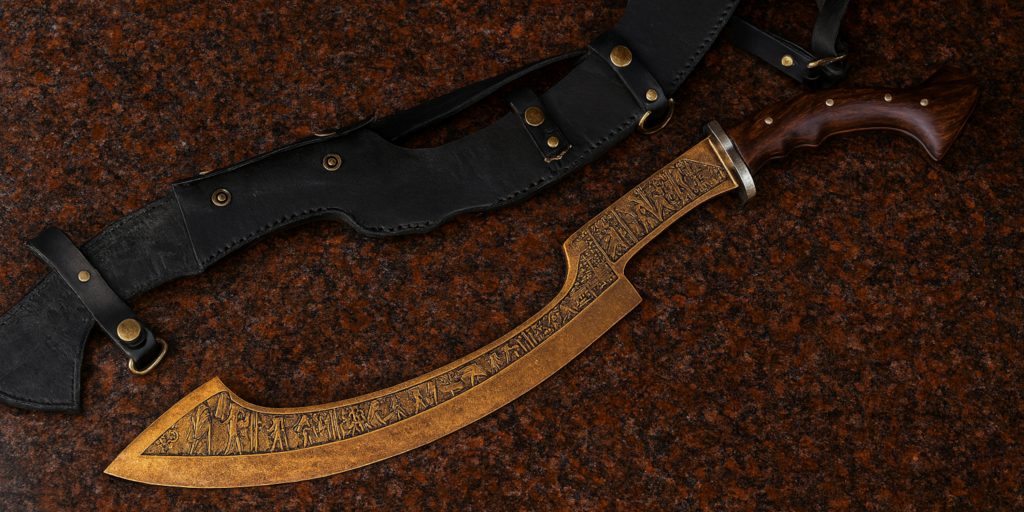
The Egyptian khopesh remains the most iconic blade of antiquity in Africa. It combined the chopping power of an axe with the reach of a sword. Other Egyptian swords included bronze leaf-shaped blades and straighter iron weapons of the later dynasties. Nubian and Kushite smiths adapted long iron swords for cavalry and infantry in the Nile valley. Carthaginian and Libyan cultures produced straight swords based on Greek and Italic models, and kopis-style curved blades influenced by Iberian traditions.
Ancient North African swords reveal a blend of local invention and external adoption. Egypt prioritised cutting power for chariot warfare, while Nubia extended the blade for reach on open ground. Carthage, situated between Africa and the wider Mediterranean, mirrored Hellenistic and Italic fashions but maintained distinctive local styles. Metallurgy shifted from bronze to iron, reflecting both technological change and military need.
- Egyptian Khopesh
- Egyptian Straight Bronze Sword (early dynastic)
- Egyptian Leaf-shaped Sword
- Nubian Iron Sword (Meroitic period)
- Carthaginian Straight Sword (influenced by Greek xiphos)
- Carthaginian Kopis-style Sword
- Libyan Short Sword
- Berber Bronze Sword (Numidian)
- Berber Iron Sword (classical era)
- Kushite Long Sword
Medieval North Africa (Berber, Arab, Moorish, Sudanese)
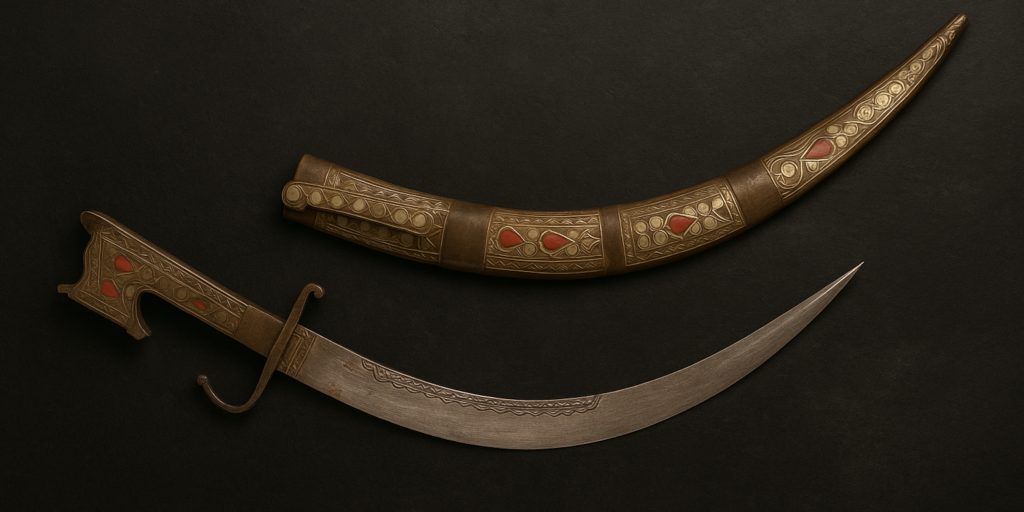
After the Arab conquest, the saif became common across the Maghreb. Almoravid and Almohad dynasties maintained straight and curved blades, used alongside Berber styles. The Tuareg developed the takoba, a straight, double-edged sword carried by warriors and nobles. Along the Nile, the kaskara appeared as a versatile double-edged weapon, associated with Nubian and Sudanese Islamic kingdoms.
Swords of this period demonstrate the influence of Islamicate arms, with forms spread by conquest and pilgrimage. The takoba and kaskara are particularly significant because they persisted for centuries with only minor variations, showing both cultural continuity and their effectiveness in the environment. Berber and Moorish blades reveal the interchange between North Africa and al-Andalus.
- Maghrebi Nimcha (early forms)
- Moorish Saif (Andalusian type)
- Fatimid Straight Sword
- Almoravid Sword
- Almohad Sword
- Berber Saif with Cross-hilt
- Early Tuareg Takoba (medieval form)
- Nubian Longsword (post-Meroitic Christian kingdoms)
- Moroccan Curved Saif
- Sudanese Two-handed Sword
Early Modern North Africa (1500–1800)
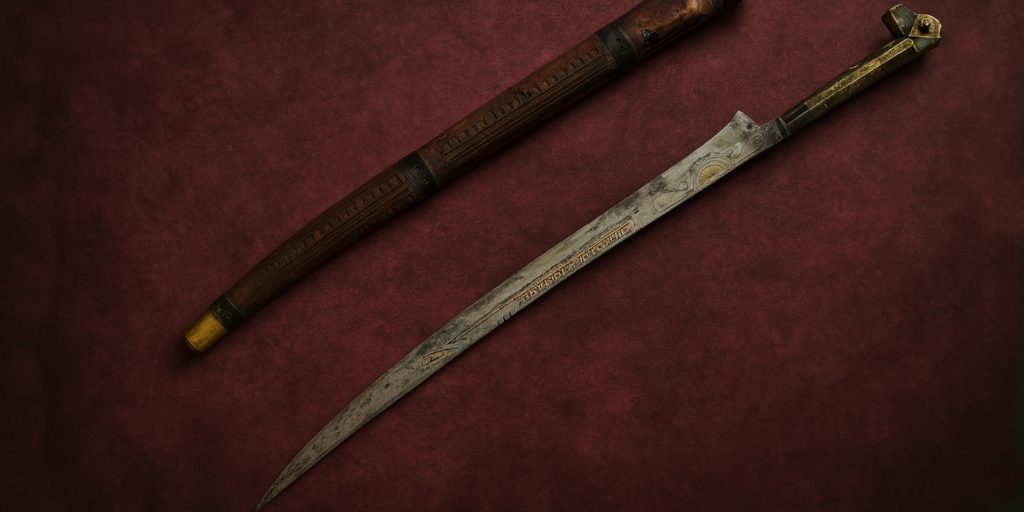
The Moroccan nimcha became widespread, noted for its curved blade and hooked quillon block. The Algerian flyssa developed among the Kabyle, slender and needle-pointed, intended for penetrating armour or mail. Tuareg smiths perfected the takoba into recognisable forms with leather-covered hilts. In the Sudan, the kaskara remained central, with long straight blades. Many swords were mounted with imported European steel, particularly from Solingen.
This era reflects the globalisation of swordsmithing. African hilts encased imported blades, while decoration expressed local identity. The flyssa shows Kabyle emphasis on both utility and artistry, with chiselled and engraved decoration. The nimcha demonstrates Moroccan adaptation of sabre forms to their own martial culture. Despite foreign steel, the cultural distinctiveness of hilts and scabbards ensured that these swords retained regional character.
- Moroccan Nimcha (hooked hilt type)
- Moroccan Saif (curved cavalry sabre)
- Algerian Flyssa (Kabyle sword)
- Berber Kaskara (spread southwards)
- Tuareg Takouba (classic form)
- Tuareg Broad Takouba
- Tuareg Needle-point Takouba
- Saharan Tebu Sword
- Chadian Kanuri Sword
- Ottoman-influenced Saif (in North Africa)
West African (Sahel & Forest Kingdoms, 1000–1800)
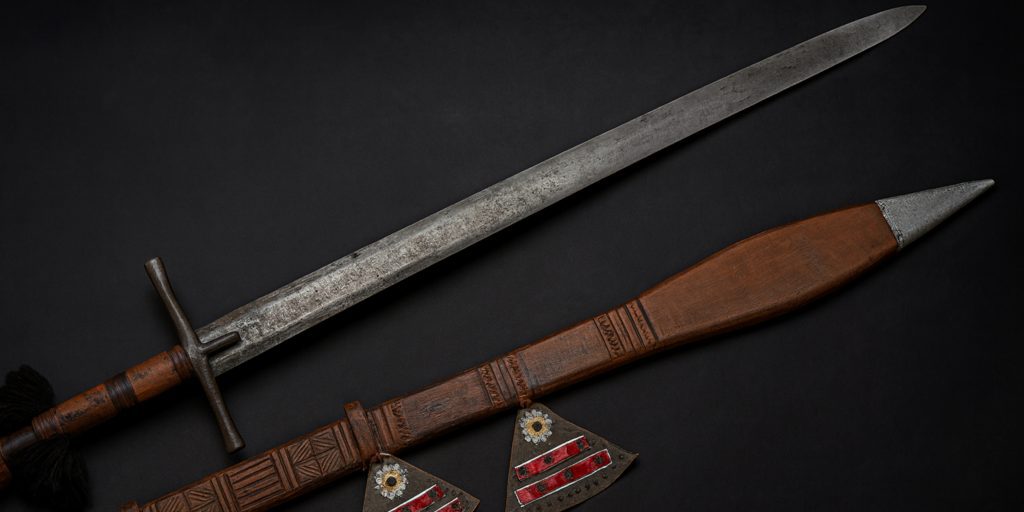
Cavalry-based empires such as Mali, Songhai, and Kanem-Bornu employed straight, double-edged iron swords suited to mounted combat. Among forest kingdoms, swords took on courtly and symbolic roles. The Ashanti used the akrafena, both functional and ceremonial, with gold or silver decoration in royal contexts. Dahomey produced ceremonial swords that signified state power. Yoruba smiths forged ritual swords for the Ogboni society. Benin created richly decorated bronze and ivory-hilted swords as part of its courtly regalia.
In West Africa, swords often carried greater symbolic than battlefield value, especially in forest states where muskets and spears were dominant. Yet cavalry swords of the Sahel remained essential for mounted elites. The artistry of Benin and Ashanti swords illustrates the link between metalwork, kingship, and spiritual authority. These swords are as much political instruments as they are weapons.
- Hausa Kaskara
- Hausa Broad-blade Sword
- Kanem-Bornu Double-edged Sword
- Fulani Sword
- Songhai Cavalry Sword
- Mali Empire Short Sword
- Mossi Cavalry Sword
- Mandinka Sword
- Wolof Straight Sword
- Ashanti Akrafena (ritual sword)
- Ashanti State Sword (Mponponsuo type)
- Ashanti Ceremonial Sword (cross-hilt type)
- Ashanti Execution Sword
- Dahomey Ceremonial Sword
- Dahomey Functional Battle Sword
- Yoruba Court Sword
- Yoruba Ritual Ogboni Sword
- Igbo Iron Sword (ceremonial)
- Benin Bronze-hilt Sword
- Benin Court Sword (bronze decorated)
Central Africa (Congo Basin & Great Lakes, 1200–1800)
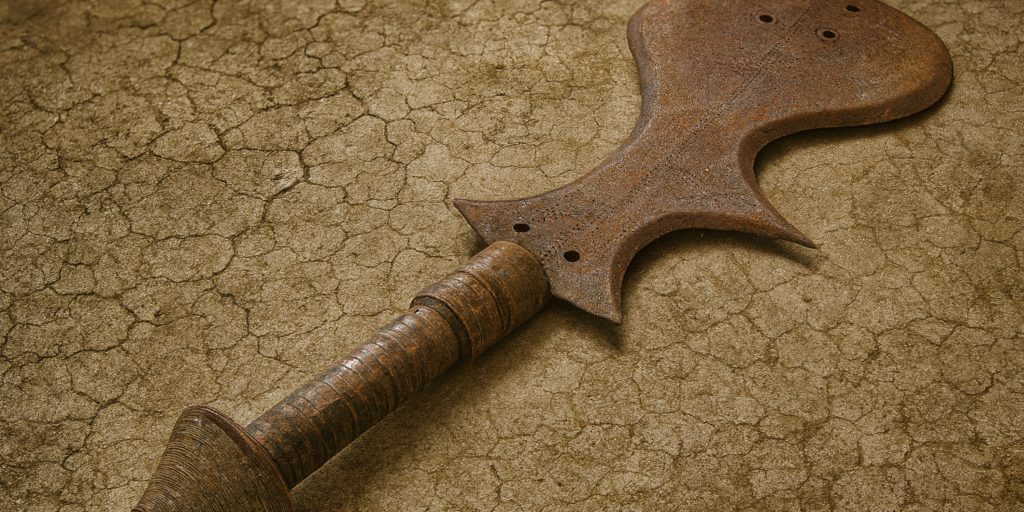
Central Africa is known for prestige swords of extraordinary shapes. The Kuba ikul was a short double-edged sword used as a status symbol. The Mangbetu developed sickle-like blades with anthropomorphic features. The Azande carried long straight swords, as well as distinctive throwing swords that blurred the line between projectile and blade. Groups such as the Ngombe, Yaka, and Songye produced ceremonial swords often called execution swords, with broad and sculptural blades.
Here the sword was more often a symbol of status than a battlefield necessity. The complexity of shapes showed technical mastery in ironworking and reinforced the authority of rulers and chiefs. Some were indeed functional, but their elaborate forms, often impractical in combat, marked them as insignia of judicial and ritual office. Central African swords embody the link between metallurgy and social hierarchy.
- Kuba Ikul Sword
- Kuba Prestige Sword (decorated)
- Mongo Execution Sword
- Songye Ceremonial Sword
- Luba Prestige Sword
- Luba Warrior Sword
- Mangbetu Sword (sickle-shaped)
- Mangbetu Prestige Sword
- Azande Long Iron Sword
- Azande Throwing Sword (hybrid weapon)
- Azande Prestige Sword
- Ngala Execution Sword
- Ngombe Execution Sword (prestige)
- Ngombe Warrior Sword
- Boa Prestige Sword
- Tetela Sword
- Chokwe Warrior Sword
- Chokwe Prestige Sword
- Yaka Sword (flared blade)
- Yaka Ceremonial Sword
East Africa (Ethiopia, Sudan, Swahili Coast, 1200–1800)

Ethiopia’s shotel, with its deeply curved blade, was intended to strike behind an opponent’s shield. The gurade was a straighter companion weapon. Along the Sudanese Nile, the kaskara remained prevalent. The Beja carried long straight swords with leather-covered hilts. On the Swahili Coast, Arab-influenced saif types were common, often mounted with imported Indian Ocean blades. Somali smiths produced short swords such as the billao and belawa.
East African swords reveal the interplay between indigenous needs and foreign trade. Ethiopian forms maintained a distinct martial identity rooted in local shield combat. Coastal swords, however, show absorption of Indian and Arab influences, reflecting centuries of maritime exchange. The kaskara and Beja blades demonstrate continuity of Sudanic traditions, valued for both combat and status.
- Ethiopian Shotel
- Ethiopian Gurade Sword
- Ethiopian Cavalry Sword (straight iron type)
- Ethiopian Broad Shotel
- Ethiopian Ritual Sword
- Oromo Sword
- Somali Billao (dagger-like short sword)
- Somali Belawa (short sword)
- Swahili Saif (Arab-influenced)
- Swahili Coast Ceremonial Sword
- Nubian Kaskara (Christian kingdoms)
- Sudanese Kaskara (Islamic period)
- Beja Sword
- Beja Dagger
- Funj Sultanate Sword
- Dinka Sword (long iron blade)
- Shilluk Sword
- Nuer Sword
- Bari Sword
- Tigray Sword
Southern Africa (Zulu, Shona, Tswana, Nguni, 1500–1800)

The dominant weapon in Southern Africa was the spear, yet iron swords were produced in limited numbers. The Zulu are recorded with long-bladed prestige swords, although the iklwa spear was their primary battlefield weapon. Shona, Tswana, and Sotho groups made iron swords, often short and broad, sometimes reserved for ritual or chiefly use.
In Southern Africa, swords never displaced the spear as a core military arm. Instead, they developed as secondary or ceremonial weapons. Their rarity gave them prestige value. Surviving examples show careful smithing, with decorative file-work and occasional symbolic markings.
- Zulu Iklwa Sword (long-bladed variant of spear)
- Zulu Long-blade Sword (rare prestige)
- Nguni Short Sword
- Shona Iron Sword
- Shona Ritual Sword
- Tswana Iron Sword
- Tswana Prestige Sword
- Sotho Sword
- Venda Sword
- Mapungubwe Iron Sword
Colonial/19th Century North & Sahel
The nineteenth century brought profound change. Firearms spread across Africa, yet swords persisted in ceremonial, symbolic, and sometimes practical roles. North African nimchas and flyssas became heavily decorated. Tuareg and Hausa warriors carried takoba and kaskara with European blades mounted in local hilts. In West Africa, Ashanti, Dahomey, and Yoruba court swords continued as insignia of rank. Central African prestige swords gained new forms under colonial observation, often with brass or ivory hilts. In East Africa, the Mahdist uprising in Sudan featured kaskara swords, while Ethiopian warriors carried both shotels and European-influenced blades.
By this period swords rarely dominated battlefields but continued to embody authority. European blades became common, but African hilts preserved identity. Swords also became symbols of resistance, as in Mahdist Sudan and Ethiopia’s defence against Italy. They remained vital in ceremony, oath-taking, and regalia, ensuring their survival into the modern era.
- Moroccan Nimcha (19th c. decorated)
- Moroccan Saif (cavalry type)
- Algerian Flyssa (long-bladed)
- Algerian Flyssa (short type)
- Tuareg Takoba (19th c. forms)
- Tuareg Prestige Takoba (silver decorated)
- Hausa Kaskara (colonial period)
- Kanuri Sword (colonial form)
- Fulani Court Sword
- Bornu Prestige Sword
Colonial/19th Century West Africa
- Ashanti Akrafena (battle version)
- Ashanti Ceremonial Akrafena
- Dahomey Ceremonial Sword (parade type)
- Yoruba Ogboni Sword (late form)
- Igbo Ritual Sword
- Benin Bronze Ceremonial Sword
- Benin Royal Sword
- Mandinka Colonial Sword
- Wolof Prestige Sword
- Mossi Court Sword
Colonial/19th Century Central Africa
- Kuba Ikul (19th c. decorated)
- Kuba Prestige Sword (brass decorated)
- Mongo Execution Sword (19th c.)
- Mangbetu Ceremonial Sword
- Mangbetu Prestige Sword (copper alloy hilt)
- Azande Long Sword (colonial form)
- Azande Prestige Sword (19th c.)
- Ngala Execution Sword (late form)
- Ngombe Prestige Sword (19th c.)
- Yaka Sword (colonial decorated)
- Songye Ritual Sword
- Tetela Prestige Sword
- Chokwe Ritual Sword
- Chokwe Prestige Sword (brass inlay)
- Luba Prestige Sword (ivory hilt)
- Boa Ceremonial Sword
- Ngbaka Sword
- Bembe Sword
- Pende Sword
- Suku Sword
Colonial/19th Century East Africa
- Ethiopian Shotel (modernised)
- Ethiopian Gurade Sword (late 19th c.)
- Ethiopian Sword with European blades
- Oromo Sword (colonial form)
- Somali Billao (19th c.)
- Somali Belawa Sword (colonial form)
- Swahili Saif (19th c.)
- Swahili Ceremonial Sword (coastal sultanates)
- Sudanese Kaskara (Mahdist era)
- Sudanese Broad Kaskara
- Beja Sword (19th c.)
- Beja Prestige Sword
- Funj Sword (colonial form)
- Dinka Sword (colonial period)
- Shilluk Sword (19th c.)
- Nuer Sword (late iron)
- Bari Sword (colonial period)
- Tigray Sword (19th c.)
- Eritrean Sword
- Harari Sword
Colonial/19th Century Southern Africa
- Zulu Long-blade Sword (rare prestige weapon)
- Zulu Officer Sword (colonial adoption)
- Nguni Iron Sword
- Shona Sword (19th c.)
- Shona Ritual Sword (colonial era)
- Tswana Sword (late form)
- Sotho Sword (19th c.)
- Venda Sword (19th c.)
- Pedi Sword
- Ngoni Sword
Unique and Prestige Blades (Across Cultures)
- Royal Ashanti Sword with gold hilt
- Benin Bronze Sword with figures
- Mangbetu Anthropomorphic Sword
- Ngombe Execution Sword (paddle-shaped)
- Luba Ivory-hilt Sword
- Yaka Sword with human figure hilt
- Kuba Sword with copper inlay
- Ethiopian Lion-head Sword
- Tuareg Silver-hilt Takoba
- Algerian Flyssa with silver inlay
- Hausa Sword with Qur’anic inscriptions
- Moroccan Nimcha with European blade
- Sudanese Mahdist Sword with talismanic inscriptions
- Somali Sword with ivory hilt
- Swahili Sword with Indian blade
- Ashanti Sword with gold leaf decoration
- Dahomey Sword with European blade
- Yoruba Sword with ritual markings
- Igbo Sword with bronze hilt
- Benin Sword with ivory hilt
- Ngombe Sword with decorated copper hilt
- Mangbetu Sword with ivory pommel
- Azande Sword with decorated scabbard
- Ethiopian Sword with Italian blade (colonial influence)
- Moroccan Saif with French blade
- Tuareg Sword with Ottoman blade
- Hausa Sword with decorative leather scabbard
- Beja Sword with engraved hilt
- Somali Sword with silver hilt
- Zulu Prestige Sword with decorative carvings
African swords cannot be reduced to single archetypes. In some regions they were practical cavalry or infantry weapons, in others they were regalia bound to kingship and ritual. The khopesh, the takoba, the shotel, the akrafena, the ikul, and the flyssa each tell a different story of how metallurgy, warfare, and symbolism intersected across time. The study of African swords requires attention not only to battlefield use but also to social meaning, for in Africa the sword was as often a sign of legitimacy as it was a tool of war.

